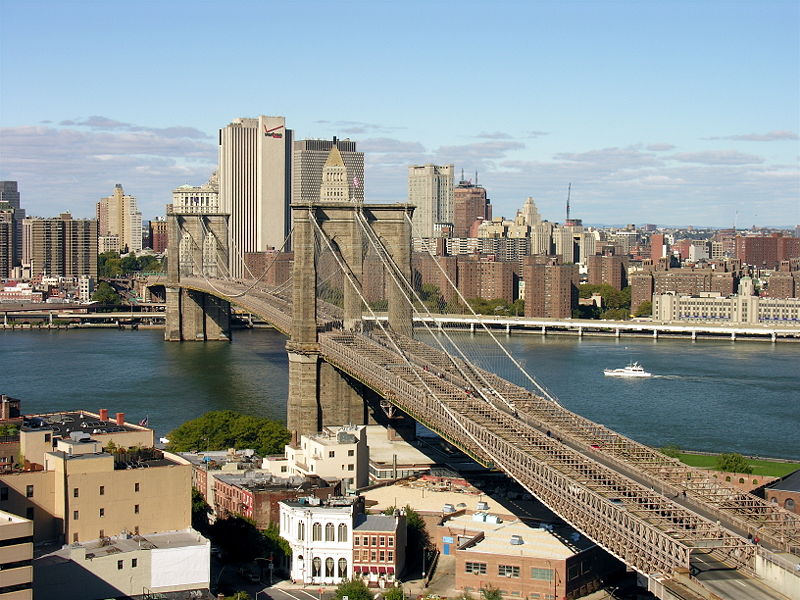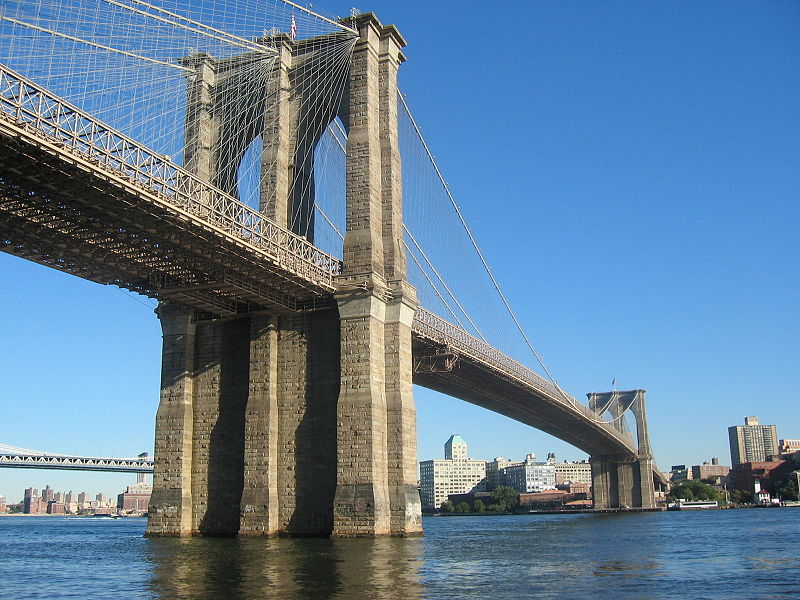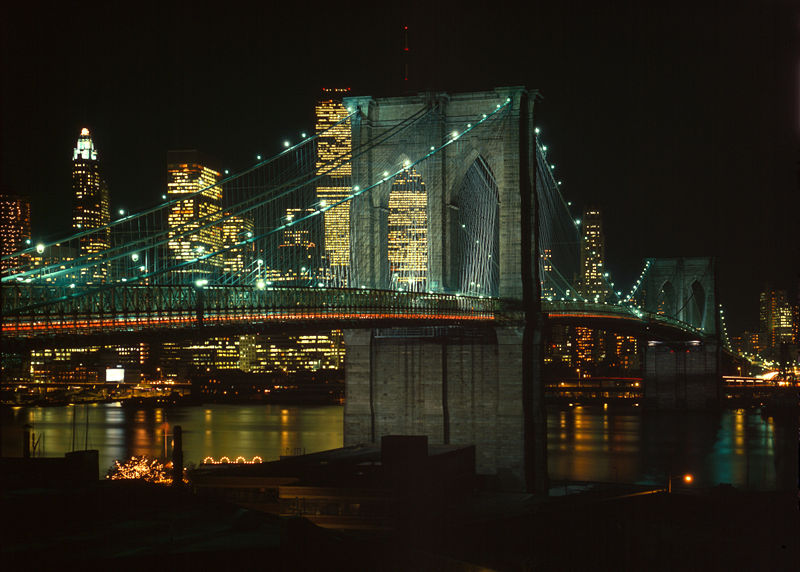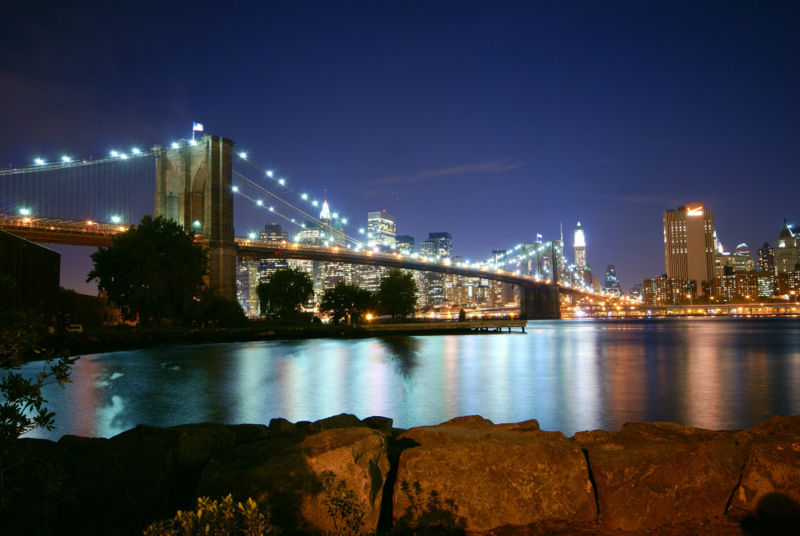| |||||||
Europe
North AmericaSouth AmericaAsiaAustralia and OceaniaAfrica |
Смотрите также: Brooklyn Bridge The Brooklyn Bridge, one of the oldest suspension bridges in the United States, stretches 5,989 feet (1825 m) over the East River, connecting the New York City boroughs of Manhattan and Brooklyn (on Long Island). Upon completion, it was the longest suspension bridge in the world, the first steel-wire suspension bridge, and the first bridge to connect to Long Island. Originally referred to as the New York and Brooklyn Bridge, it was dubbed the Brooklyn Bridge in an 1867 letter to the editor of the Brooklyn Daily Eagle, and formally so named by the city government in 1915. Since its opening, it has become an iconic part of the New York skyline. It was designated a National Historic Landmark in 1964.
Brooklyn Bridge Carries Motor vehicles (cars only), elevated trains (until 1944), streetcars (until 1950), pedestrians, and bicycles Crosses East River Locale New York City (Manhattan–Brooklyn) Designer John Augustus Roebling Design Suspension/Cable-stay Hybrid Longest span 1,595 feet 6 inches (486.3 m) Total length 5,989 feet (1825 m) Width 85 feet (26 m) Clearance below 135 feet (41 m) at mid-span Opening date May 24, 1883
Construction The Brooklyn Bridge opened to great fanfare in May 1883. The names of John Roebling, Washington Roebling, and Emily Warren Roebling are inscribed on the structure as its builders. Construction began on January 3, 1870. The Brooklyn Bridge was completed thirteen years later and was opened for use on May 24, 1883. The Brooklyn Bridge might not have been built had it not been for Emily Warren Roebling. Most history books cite her father-in-law John Roebling and her husband Washington Roebling as the bridge’s builders. Early into construction in 1872, however, collapsing bridge timbers crushed John Roebling’s legs, leaving him incapacitated; he later died of an infection related to this injury and left his son, Washington Roebling in charge of the bridge. However, not long after taking charge of the bridge, Washington Roebling suffered a paralyzing injury as well, the result of decompression sickness. This condition plagued many of the underwater workers, in different capacities, as the condition was relatively unknown at the time and in fact was first called "caisson disease" by the project physician Dr. Andrew Smith. With both men out of commission, Emily Warren Roebling took over. Under her husband’s guidance, Emily had studied higher mathematics, the calculations of catenary curves, the strengths of materials, bridge specifications, and the intricacies of cable construction. She spent the next 11 years supervising the bridge’s construction. The opening ceremony was attended by several thousand people and many ships were present in the East Bay for the occasion. President Chester Arthur and New York Mayor Franklin Edson crossed the bridge to celebratory cannon fire and were greeted by Brooklyn Mayor Seth Low when they reached the Brooklyn-side tower. Arthur shook hands with Washington Roebling at Roebling's home, after the ceremony. Washington Roebling was unable to attend the ceremony but held a celebratory banquet at his house on the day of the bridge opening. Further festivity included the performance of a band, gunfire from ships, and a fireworks display.
On that first day, a total of 1,800 vehicles and 150,300 people crossed what was then the only land passage between Manhattan and Long Island. The bridges main span over the East River is 1,595 feet 6 inches (486.3 m). The bridge cost $15.5 million to build and approximately 27 people died during its construction. One week after the opening, on May 30, 1883, a rumor that the Bridge was going to collapse caused a stampede, which crushed and killed at least twelve people. On May 17, 1884, P. T. Barnum helped to squelch doubts about the bridges stability—while publicizing his famous circus—when one of his most famous attractions, Jumbo, led a parade of 21 elephants over the Brooklyn Bridge. At the time it opened, it was the longest suspension bridge in the world — 50% longer than any previously built — and it has become a treasured landmark. For several years the towers were the tallest structures in the Western Hemisphere. Since the 1980s, it has been floodlit at night to highlight its architectural features. The towers are built of limestone, granite, and Rosendale cement. Their architectural style is neo-Gothic, with characteristic pointed arches above the passageways through the stone towers. The bridge was designed by German-born John Augustus Roebling in Trenton, New Jersey. Roebling had earlier designed and constructed other suspension bridges, such as Roebling's Delaware Aqueduct in Lackawaxen, Pennsylvania, the John A. Roebling Suspension Bridge in Cincinnati, Ohio and the Waco Suspension Bridge in Waco, Texas, that served as the engineering prototypes for the final design.
During surveying for the East River Bridge project, Roeblings foot was badly injured by a ferry, pinning it against a pylon; within a few weeks, he died of tetanus. His son, Washington, succeeded him, but in 1872 was stricken with caisson disease (decompression sickness, commonly known as "the bends"), due to working in compressed air in caissons. The occurrence of the disease in the caisson workers caused him to halt construction of the Manhattan side of the tower 30 feet (10 m) short of bedrock when soil tests underneath the caisson found bedrock to be even deeper than expected. Today, the Manhattan tower rests only on sand. Washington's wife, Emily Warren Roebling, became his aide, learning engineering and communicating his wishes to the on-site assistants. When the bridge opened, she was the first person to cross it. Washington Roebling rarely visited the site again. At the time the bridge was built, the aerodynamics of bridge building had not been worked out. Bridges were not tested in wind tunnels until the 1950s — well after the collapse of the original Tacoma Narrows Bridge (Galloping Gertie) in 1940. It is therefore fortunate that the open truss structure supporting the deck is by its nature less subject to aerodynamic problems. Roebling designed a bridge and truss system that was six times as strong as he thought it needed to be. Because of this, the Brooklyn Bridge is still standing when many of the bridges built around the same time have vanished into history and been replaced. This is also in spite of the substitution of inferior quality wire in the cabling supplied by the contractor J. Lloyd Haigh — by the time it was discovered, it was too late to replace the cabling that had already been constructed. Roebling determined that the poorer wire would leave the bridge four rather than six times as strong as necessary, so it was eventually allowed to stand, with the addition of 250 cables. Diagonal cables were installed from the towers to the deck, intended to stiffen the bridge. They turned out to be unnecessary, but were kept for their distinctive beauty. After the collapse in 2007 of the I-35W highway bridge in the city of Minneapolis, increased public attention has been brought to bear on the condition of bridges across the US, and it has been reported that the Brooklyn Bridge approach ramps received a rating of "poor" at its last inspection. According to a NYC Department of Transportation spokesman, "The poor rating it received does not mean it is unsafe. Poor means there are some components that have to be rehabilitated. A $725 million project to replace the approaches and repaint the bridge is scheduled to begin in 2009. The construction of the Brooklyn Bridge is detailed in the 1972 book The Great Bridge by David McCullough and Brooklyn Bridge (1981), the first PBS documentary film ever made by Ken Burns. Burns drew heavily on McCulloughs book for the film and used him as narrator. It is also described in Seven Wonders of the Industrial World, a BBC docudrama series with accompanying book.
Pedestrian access The Brooklyn Bridge is accessible from the Brooklyn entrances of Tillary/Adams Streets, Sands/Pearl Streets, and Exit 28B of the eastbound Brooklyn-Queens Expressway. In Manhattan, motor cars can enter from either direction of the FDR Drive, Park Row, Chambers/Centre Streets, and Pearl/Frankfort Streets. Pedestrian access to the bridge from the Brooklyn side is from either Tillary/Adams Streets (in between the auto entrance/exit), or a staircase on Prospect St between Cadman Plaza East and West. In Manhattan, the pedestrian walkway is accessible from the end of Centre Street, or through the unpaid south staircase of Brooklyn Bridge-City Hall IRT subway station. The Brooklyn Bridge has a wide pedestrian walkway open to walkers and cyclists, in the center of the bridge and higher than the automobile lanes. While the bridge has always permitted the passage of pedestrians across its span, its role in allowing thousands to cross takes on a special importance in times of difficulty when usual means of crossing the East River have become unavailable. During transit strikes by the Transport Workers Union in 1980 and 2005 the bridge was used by people commuting to work, with Mayors Koch and Bloomberg crossing the bridge as a gesture to the affected public. Following the 1965, 1977 and 2003 Blackouts and most famously after the September 11, 2001 attacks on the World Trade Center, the bridge was used by people in Manhattan to leave the city after subway service was suspended. The massive numbers of people on the bridge could not have been anticipated by the original designer, yet John Roebling designed it with three separate systems managing even unanticipated structural stresses. The bridge has a suspension system, a diagonal stay system, and a stiffening truss. "Roebling himself famously said if anything happens to one of [his] systems, 'The bridge may sag, but it will not fall. The movement of large numbers of people on a bridge creates pedestrian oscillations or "sway" as the crowd lifts one foot after another, some falling inevitably in synchronized cadences. The natural sway motion of people walking causes small sideways oscillations in a bridge, which in turn cause people on the bridge to sway in step, increasing the amplitude of the bridge oscillations and continually reinforcing the effect. This high-density traffic causes a bridge to appear to move erratically or "to wobble" as happened at opening of the London Millennium Footbridge in 2000. Comments: 0 |
|
|||||













































